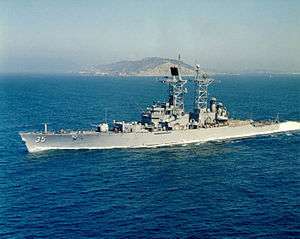Nuclear powered cruisers of the United States Navy
%2C_USS_Long_Beach_(CGN-9)_and_USS_Bainbridge_(DLGN-25)_underway_in_the_Mediterranean_Sea_during_Operation_Sea_Orbit%2C_in_1964.jpg)
The United States Navy at one time had nuclear powered cruisers as part of its fleet. The first such ship was USS Long Beach (CGN-9). Commissioned in late summer 1961, she was the world's first nuclear powered surface combatant.[1] She was followed a year later by USS Bainbridge (DLGN-25). While Long Beach was a 'true cruiser', meaning she was designed and built as a cruiser,[2] Bainbridge began life as a frigate, though at that time the Navy was using the hull code "DLGN" for "destroyer leader, guided missile, nuclear".[3] This was prior to the enactment of the 1975 ship reclassification plan, in which frigates (DLG/DLGN), (which were essentially large destroyers), were reclassified as cruisers, so that the US Navy's numbers would compete with those of the Soviet Navy.[4] Long Beach, the largest of all the nuclear cruisers, was equipped with a C1W cruiser reactor, while all the others were equipped with D2G destroyer reactors.
In the summer of 1964, Long Beach and Bainbridge would meet up with USS Enterprise (CVAN-65), the Navy's first nuclear powered aircraft carrier,[5] to form Task Force One, an all-nuclear powered naval unit. They would commence Operation Sea Orbit, in which they circumnavigated the globe, without refuelling. It was a remarkable achievement for its time, a naval group capable of sailing over 48,000 kilometers (26,000 nmi; 30,000 mi) in just 65 days, without replenishment.[6]
In the spring of 1967 came the Navy's third nuclear powered cruiser, (though initially labeled a frigate), USS Truxtun (DLGN-35), a heavily modified Belknap-class cruiser. Truxtun would be followed by the 2-ship California class, beginning with USS California (CGN-36) in February 1974 and USS South Carolina (CGN-37) in January 1975. The US Navy was the only fleet in the world with nuclear powered cruisers, until 1974 when the USSR would begin construction on their own nuclear battlecruiser, the Kirov class. The Soviets would build 4 in total, between 1974 and 1998.[7]
The last nuclear powered cruisers the Americans would produce would be the 4-ship Virginia class. USS Virginia (CGN-38) was commissioned in 1976, followed by USS Texas (CGN-39) in 1977, USS Mississippi (CGN-40) in 1978 and finally USS Arkansas (CGN-41) in 1980. Ultimately, all these ships would prove to be too costly to maintain[8] and they would all be retired between 1993 and 1999. A fifth Virginia-class vessel was initially planned but then cancelled.[9]
The US Navy currently has the largest fleet of nuclear powered aircraft carriers[10] and nuclear powered submarines.[11]
List of United States Navy nuclear powered cruisers
| Ship Name | Hull Number | Class | Length | Displacement | Commissioned | Decommissioned | Notes |
|---|---|---|---|---|---|---|---|
| USS Long Beach | CGN-9 | Long Beach | 721 ft 3 in (219.84 m) | 15,540 tons | 9 September 1961 | 1 May 1995 | |
| USS Bainbridge | CGN-25 | Bainbridge | 565 ft 0 in (172.21 m) | 9,100 tons | 6 October 1962 | 13 July 1996 | |
| USS Truxtun | CGN-35 | Truxtun | 564 ft 0 in (171.91 m) | 8,659 tons | 27 May 1967 | 11 September 1995 | |
| USS California | CGN-36 | California | 587 ft 0 in (178.92 m) | 10,800 tons | 16 February 1974 | 9 July 1999 | |
| USS South Carolina | CGN-37 | California | 587 ft 0 in (178.92 m) | 10,800 tons | 25 January 1975 | 30 July 1999 | |
| USS Virginia | CGN-38 | Virginia | 586 ft 0 in (178.61 m) | 11,666 tons | 11 September 1976 | 10 November 1994 | |
| USS Texas | CGN-39 | Virginia | 586 ft 0 in (178.61 m) | 11,666 tons | 10 September 1977 | 16 July 1993 | |
| USS Mississippi | CGN-40 | Virginia | 586 ft 0 in (178.61 m) | 11,666 tons | 5 August 1978 | 28 July 1997 | |
| USS Arkansas | CGN-41 | Virginia | 586 ft 0 in (178.61 m) | 11,666 tons | 18 October 1980 | 7 July 1998 |
_underway_at_sea%2C_circa_in_the_1960s.jpg) USS Long Beach
USS Long Beach
(CGN-9)_underway_in_the_Suez_Canal_on_27_February_1992.jpg) USS Bainbridge
USS Bainbridge
(CGN-25) USS Truxtun
USS Truxtun
(DLGN-35)- USS California
(CGN-36) _elevated_starboard_view.jpg) USS Virginia
USS Virginia
(CGN-38) USS Arkansas
USS Arkansas
(CGN-41)
See also
- List of United States Navy ships
- Nuclear navy
- Nuclear propulsion
- Cold war
- Supercarrier
- Nuclear submarine
- USS Enterprise (CVN-65) (World's first nuclear powered aircraft carrier)
- USS Nautilus (SSN-571) (World's first nuclear powered submarine)
References
- ↑ "USS Long Beach (CGN 9)".
- ↑ John Pike. "CGN-9 Long Beach".
- ↑ John Pike. "CGN 25 BAINBRIDGE class".
- ↑ "sci.military.naval FAQ, Part F - Surface Combatants".
- ↑ "USS Enterprise (CVN 65) Official Web Site".
- ↑ "Operation Sea Orbit Celebration: A Legacy Like No Other - Naval Historical Foundation".
- ↑ John Pike. "Kirov Class - Project 1144.2".
- ↑ "Nuclear power for surface combatants".
- ↑ John Pike. "CGN-42 AEGIS Modified Virginia".
- ↑ Kyle Mizokami (25 January 2016). "Here Is Every Aircraft Carrier in the World". Popular Mechanics.
- ↑ News Editor (15 January 2016). "The 9 Largest Submarine Fleets in the World".
External links
| Wikimedia Commons has media related to United States Navy. |
